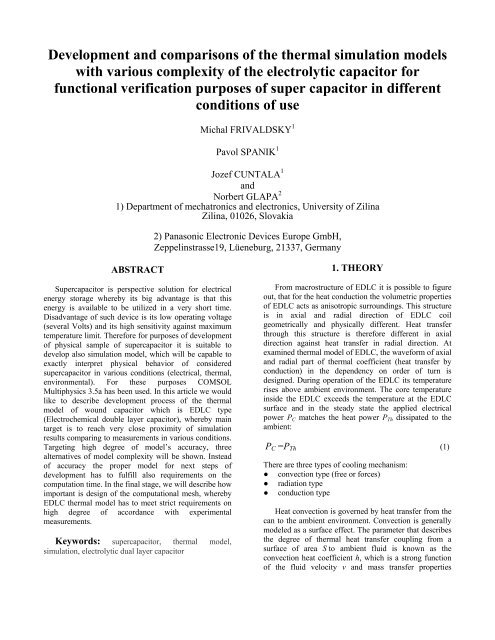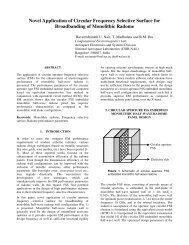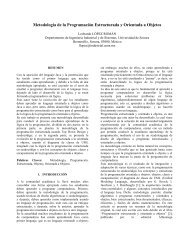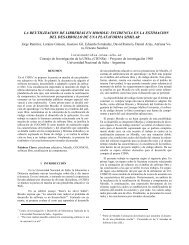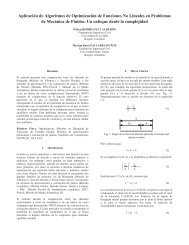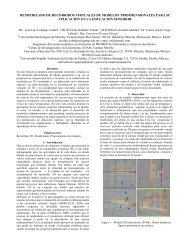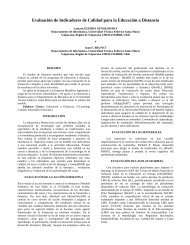Development and comparisons of the thermal simulation models ...
Development and comparisons of the thermal simulation models ...
Development and comparisons of the thermal simulation models ...
Create successful ePaper yourself
Turn your PDF publications into a flip-book with our unique Google optimized e-Paper software.
<strong>Development</strong> <strong>and</strong> <strong>comparisons</strong> <strong>of</strong> <strong>the</strong> <strong>the</strong>rmal <strong>simulation</strong> <strong>models</strong><br />
with various complexity <strong>of</strong> <strong>the</strong> electrolytic capacitor for<br />
functional verification purposes <strong>of</strong> super capacitor in different<br />
conditions <strong>of</strong> use<br />
Michal FRIVALDSKY 1<br />
Pavol SPANIK 1<br />
Jozef CUNTALA 1<br />
<strong>and</strong><br />
Norbert GLAPA 2<br />
1) Department <strong>of</strong> mechatronics <strong>and</strong> electronics, University <strong>of</strong> Zilina<br />
Zilina, 01026, Slovakia<br />
ABSTRACT<br />
Supercapacitor is perspective solution for electrical<br />
energy storage whereby its big advantage is that this<br />
energy is available to be utilized in a very short time.<br />
Disadvantage <strong>of</strong> such device is its low operating voltage<br />
(several Volts) <strong>and</strong> its high sensitivity against maximum<br />
temperature limit. Therefore for purposes <strong>of</strong> development<br />
<strong>of</strong> physical sample <strong>of</strong> supercapacitor it is suitable to<br />
develop also <strong>simulation</strong> model, which will be capable to<br />
exactly interpret physical behavior <strong>of</strong> considered<br />
supercapacitor in various conditions (electrical, <strong>the</strong>rmal,<br />
environmental). For <strong>the</strong>se purposes COMSOL<br />
Multiphysics 3.5a has been used. In this article we would<br />
like to describe development process <strong>of</strong> <strong>the</strong> <strong>the</strong>rmal<br />
model <strong>of</strong> wound capacitor which is EDLC type<br />
(Electrochemical double layer capacitor), whereby main<br />
target is to reach very close proximity <strong>of</strong> <strong>simulation</strong><br />
results comparing to measurements in various conditions.<br />
Targeting high degree <strong>of</strong> model’s accuracy, three<br />
alternatives <strong>of</strong> model complexity will be shown. Instead<br />
<strong>of</strong> accuracy <strong>the</strong> proper model for next steps <strong>of</strong><br />
development has to fulfill also requirements on <strong>the</strong><br />
computation time. In <strong>the</strong> final stage, we will describe how<br />
important is design <strong>of</strong> <strong>the</strong> computational mesh, whereby<br />
EDLC <strong>the</strong>rmal model has to meet strict requirements on<br />
high degree <strong>of</strong> accordance with experimental<br />
measurements.<br />
Keywords: supercapacitor, <strong>the</strong>rmal model,<br />
<strong>simulation</strong>, electrolytic dual layer capacitor<br />
2) Panasonic Electronic Devices Europe GmbH,<br />
Zeppelinstrasse19, Lüeneburg, 21337, Germany<br />
1. THEORY<br />
From macrostructure <strong>of</strong> EDLC it is possible to figure<br />
out, that for <strong>the</strong> heat conduction <strong>the</strong> volumetric properties<br />
<strong>of</strong> EDLC acts as anisotropic surroundings. This structure<br />
is in axial <strong>and</strong> radial direction <strong>of</strong> EDLC coil<br />
geometrically <strong>and</strong> physically different. Heat transfer<br />
through this structure is <strong>the</strong>refore different in axial<br />
direction against heat transfer in radial direction. At<br />
examined <strong>the</strong>rmal model <strong>of</strong> EDLC, <strong>the</strong> waveform <strong>of</strong> axial<br />
<strong>and</strong> radial part <strong>of</strong> <strong>the</strong>rmal coefficient (heat transfer by<br />
conduction) in <strong>the</strong> dependency on order <strong>of</strong> turn is<br />
designed. During operation <strong>of</strong> <strong>the</strong> EDLC its temperature<br />
rises above ambient environment. The core temperature<br />
inside <strong>the</strong> EDLC exceeds <strong>the</strong> temperature at <strong>the</strong> EDLC<br />
surface <strong>and</strong> in <strong>the</strong> steady state <strong>the</strong> applied electrical<br />
power PC matches <strong>the</strong> heat power PTh dissipated to <strong>the</strong><br />
ambient:<br />
PC =PTh (1)<br />
There are three types <strong>of</strong> cooling mechanism:<br />
● convection type (free or forces)<br />
● radiation type<br />
● conduction type<br />
Heat convection is governed by heat transfer from <strong>the</strong><br />
can to <strong>the</strong> ambient environment. Convection is generally<br />
modeled as a surface effect. The parameter that describes<br />
<strong>the</strong> degree <strong>of</strong> <strong>the</strong>rmal heat transfer coupling from a<br />
surface <strong>of</strong> area S to ambient fluid is known as <strong>the</strong><br />
convection heat coefficient h, which is a strong function<br />
<strong>of</strong> <strong>the</strong> fluid velocity v <strong>and</strong> mass transfer properties
(density, viscosity). The power dissipated through<br />
convection is generally given by:<br />
conv<br />
( Ts<br />
Ta<br />
P = h.<br />
S.<br />
− ) (2)<br />
Ts – surface temperature EDLC,<br />
Ta – ambient temperature,<br />
S – area <strong>of</strong> surface sleeve <strong>of</strong> EDLC,<br />
h – heat transfer coefficient convection.<br />
Fig.1. Cooling types <strong>of</strong> EDLC on <strong>the</strong> plate<br />
An approximate value <strong>of</strong> h versus velocity v is commonly<br />
used in <strong>the</strong> electrical industry [1], [2]:<br />
hconv _ apr<br />
11.<br />
( v + 0,<br />
25)<br />
2 [ W / m . K ]<br />
= (3)<br />
0,<br />
25<br />
Previous equations (2), (3) are expressing possible heat<br />
rise ∆T <strong>of</strong> EDLC. Anyway <strong>the</strong>y are not accepting many<br />
o<strong>the</strong>r important factors, such as gravimetric orientation,<br />
geometric ratio D/L, type <strong>of</strong> air flow (laminar, turbulent).<br />
Therefore heat radiation is better to be expressed by<br />
Stefan- Boltzmann´s law:<br />
4 4<br />
Prad = ε . σ.<br />
S.(<br />
Ts<br />
− Ta<br />
) = hrad<br />
. S.<br />
∆Ta<br />
_ s (4)<br />
ε – emissivity,<br />
σ – Stefan-Boltzmann´s constant,<br />
hrad – heat transfer coefficient radiation.<br />
In practical uses <strong>the</strong> total heat transfer coefficient<br />
(include convection <strong>and</strong> radiation) can by approximated<br />
by [1], [2]:<br />
0,<br />
66<br />
htot ≅ 5 + 17.(<br />
v + 0,<br />
1)<br />
(5)<br />
The core temperature <strong>of</strong> EDLC can by estimated by:<br />
∆<br />
R<br />
Tc _ s Ts<br />
_ a<br />
th _ core<br />
∆<br />
=<br />
R<br />
th<br />
Tc_s – temperature rise core surface,<br />
Ts_a – temperature rise surface ambient,<br />
Rth =1/htot.S<br />
Rth_core – combined <strong>the</strong>rmal resistances <strong>of</strong> EDLC<br />
From macrostructure <strong>of</strong> EDLC capacitor on fig.2 it is<br />
possible to conclude, that volume properties <strong>of</strong> ELDC<br />
acts as anisotropic surrounding for <strong>the</strong> heat conduction.<br />
This structure is in axial <strong>and</strong> radial direction<br />
geometrically <strong>and</strong> physically different.<br />
Fig.2. Cross – section <strong>of</strong> EDLC<br />
Label „n“ as total number <strong>of</strong> turns in four-layer<br />
structure <strong>and</strong> set j∈1, n as order <strong>of</strong> s<strong>and</strong>wich turn. The<br />
diameter <strong>of</strong> turn is being changed in dependency on order<br />
<strong>of</strong> turn according to next formula:<br />
( ) = + ( −1)<br />
r j r j w<br />
0<br />
r(j) – is internal diameter <strong>of</strong> turn in „j - th“ order,<br />
r0 – is diameter <strong>of</strong> first four-layer structure,<br />
w – is width <strong>of</strong> one turn:<br />
w= wS + 2wC<br />
+ wAl wS – is width <strong>of</strong> separator layer,<br />
wC – is width <strong>of</strong> carbon layer,<br />
wAl – is width <strong>of</strong> extruded aluminum.<br />
The area <strong>of</strong> bottom turn’s side with „j-th“ order is:<br />
(6)<br />
(7)<br />
(8)<br />
2 2<br />
S( j)<br />
= π ( r(<br />
j + 1)<br />
− r(<br />
j)<br />
)<br />
(9)
Axial part <strong>of</strong> turn’s <strong>the</strong>rmal resistance with „j-th“<br />
order was computed using next formula:<br />
a<br />
( )<br />
R j<br />
L<br />
= (1)<br />
k j S j<br />
a<br />
( ) . ( )<br />
L – is height <strong>of</strong> turn coil (m),<br />
ka – <strong>the</strong>rmal conductivity in axial direction (W/m.K)<br />
Equivalent axial <strong>the</strong>rmal conductivity <strong>of</strong> one turn <strong>of</strong><br />
EDLC shown on fig.2 is given by next equation:<br />
1<br />
R ( j)<br />
a<br />
1 1 1<br />
+ + +<br />
S C _ L Al<br />
R ( j)<br />
R ( j)<br />
R ( j)<br />
R<br />
= (11)<br />
a<br />
a<br />
a<br />
1<br />
C _ R<br />
a<br />
( j)<br />
C L<br />
Ra _ – axial <strong>the</strong>rmal resistance <strong>of</strong> carbon layer on<br />
C R<br />
Ra _<br />
left side,<br />
– axial <strong>the</strong>rmal resistance <strong>of</strong> carbon layer on<br />
right side,<br />
R – axial <strong>the</strong>rmal resistance <strong>of</strong> extruded aluminum<br />
Al<br />
a<br />
layer,<br />
R – axial <strong>the</strong>rmal resistance <strong>of</strong> separator layer<br />
S<br />
a<br />
Dependency <strong>of</strong> <strong>the</strong>rmal coefficient for heat transfer by<br />
conduction in one turn <strong>of</strong> EDLC with „j-th“ order should<br />
be expressed from (4,5,6) by next formula:<br />
L<br />
ka<br />
( j)<br />
= (12)<br />
R ( j).<br />
S(<br />
j)<br />
a<br />
Fig.3. Waveform <strong>of</strong> axial conductivity in dependency on <strong>the</strong><br />
number <strong>of</strong> turn<br />
Total <strong>the</strong>rmal resistance <strong>of</strong> one turn for „j-th“ order in<br />
radial direction could be obtained as:<br />
S<br />
C _ L Al<br />
C _ R<br />
R ( j)<br />
= R ( j)<br />
+ R + R ( j)<br />
+ R ( j)<br />
(13)<br />
r<br />
r<br />
r<br />
r<br />
r<br />
After adding several radial resistances we can obtain<br />
dependency <strong>of</strong> equivalent radial <strong>the</strong>rmal conductivity in<br />
one turn with „j-th“ order as follows:<br />
k ( j)<br />
r<br />
r<br />
ln<br />
r<br />
j −1<br />
= (14)<br />
2.<br />
π.<br />
L.<br />
R ( j)<br />
j<br />
r<br />
Fig.4. Waveform <strong>of</strong> radial conductivity in dependency on <strong>the</strong><br />
number <strong>of</strong> turn<br />
2. DEVELOPMENT OF THERMAL<br />
MODELS OF EDLC<br />
3D geometrical model <strong>of</strong> EDLC capacitor with<br />
minimal complexity is shown on fig.5. It is representing<br />
<strong>the</strong> scroll coil <strong>of</strong> mentioned s<strong>and</strong>wich structure (fig.1)<br />
with diameter <strong>of</strong> 28 mm <strong>and</strong> height <strong>of</strong> 125 mm.<br />
Compressed foils on top <strong>and</strong> bottm side are made from<br />
extruded aluminum <strong>and</strong> have prepared area for electrical<br />
contacts connection. The core <strong>of</strong> EDLC is separated from<br />
aluminum chat through electrolyte layer.<br />
Fig.5. Minimal complexity model <strong>of</strong> 1xEDLC<br />
Each subdomain <strong>of</strong> EDLC has physical <strong>the</strong>rmal<br />
coefficients defined using material libraries from<br />
COMSOL heat-transfer module [3]. Coefficient <strong>of</strong> core’s<br />
<strong>the</strong>rmal conductivity creates tensor <strong>of</strong> 2 grade in which<br />
part <strong>of</strong> axial <strong>and</strong> radial <strong>the</strong>rmal conductivity are being
included. For <strong>the</strong> higher accuracy <strong>of</strong> results from <strong>the</strong>rmal<br />
<strong>simulation</strong>s we decided to develop also o<strong>the</strong>r <strong>models</strong><br />
whose geometrical properties will be in <strong>the</strong> closer<br />
proximity to real physical sample. Next figure is showing<br />
1xEDLC improved complexity model.<br />
Fig.6. Improved complexity model <strong>of</strong> 1xEDLC<br />
3. RESULTS AND COMPARISSONS OF<br />
SIMULATION AND MEASUREMENT<br />
EXPERIMENTS<br />
Surroundings <strong>of</strong> EDLC model is air with temperature<br />
<strong>of</strong> Tamb = 27,3 °C. Heat power in <strong>the</strong> core EDLC was set<br />
to Ploss = 0,56 W. Next figure is showing result from<br />
<strong>simulation</strong> experiment <strong>of</strong> simple complexity model for<br />
steady state operation.<br />
Fig.7. Interpretation <strong>of</strong> temperature distribution in whole<br />
volume <strong>of</strong> EDLC - simple complexity model,<br />
Ploss = 0,56 W, T amb = 27,3 °C<br />
These results have been compared to experimental<br />
measurement <strong>of</strong> physical sample. The parameters <strong>of</strong><br />
experimental measurement where <strong>the</strong> same as during<br />
<strong>simulation</strong> experiment so Iload = 30 A, DCREDLC = 0,63<br />
mΩ, Ploss = 0,56 W, Tamb = 27,3 °C. Charging process <strong>of</strong><br />
capacitor lasts 51 sec. with applied voltage <strong>of</strong> 2,5 V,<br />
discharge process starts after 0,5 sec. <strong>and</strong> lasts 51 sec.<br />
with applied voltage <strong>of</strong> 0 V. Next figure is showing result<br />
from <strong>the</strong>rmal measurement <strong>of</strong> physical sample.<br />
Fig.8. Result from experimental measurement <strong>of</strong> EDLC,<br />
Ploss = 0,56 W, T amb = 27,3 °C<br />
Relative error between <strong>simulation</strong> <strong>and</strong> measurement for<br />
subdomains - core <strong>of</strong> EDLC <strong>and</strong> case <strong>of</strong> EDLC, were<br />
computed based on next equation:<br />
T<br />
rel_<br />
err<br />
∇T<br />
T<br />
= =<br />
T<br />
amb<br />
core_<br />
meas<br />
T<br />
−T<br />
amb<br />
core_<br />
sim<br />
=<br />
31,<br />
8−31,<br />
987<br />
= −0,<br />
68%<br />
27,<br />
3<br />
Table 1. Relative errors between <strong>simulation</strong> (simple model)<br />
<strong>and</strong> measurement for subdomain CORE <strong>and</strong> CASE <strong>of</strong> EDLC<br />
IRMS [A] Ploss [W] Trel_error<br />
CORE 30A 0,561 -0,68 %<br />
CASE 30A 0,561 -5,32 %<br />
CORE 50A 1,33 -0,34 %<br />
CASE 50A 1,33 -9,5 %<br />
As was previously mentioned, facing requirements on<br />
higher accuracy <strong>of</strong> <strong>simulation</strong> model, we decided to<br />
develop improved complexity model. This model has<br />
against simple complexity model two added subdomains:<br />
aluminum coat, <strong>and</strong> air between aluminum coat <strong>and</strong><br />
minimal complexity model (fig.6.). The problems which<br />
became into account after adding this subdomains was<br />
increased number <strong>of</strong> total elements <strong>of</strong> computation mesh<br />
(from 10 4 to 10 5 ). This fact has reflected into longer<br />
computation time. Therefore <strong>the</strong> optimization <strong>of</strong> mesh<br />
size manually have been done to improve computational<br />
time whereby, better accuracy <strong>of</strong> model had to be<br />
maintained.<br />
Comparisons <strong>of</strong> results from <strong>simulation</strong> <strong>of</strong> minimal<br />
complexity <strong>and</strong> improved complexity model are shown<br />
on fig.8. The figure represents dependency <strong>of</strong> temperature<br />
distribution in <strong>the</strong> core <strong>of</strong> ELDC in x-cut direction in <strong>the</strong><br />
middle <strong>of</strong> EDLC height. From fig.9. it can be seen that<br />
due to improvement <strong>of</strong> 1xEDLC model <strong>the</strong> temperature
difference between core, <strong>and</strong> between can <strong>of</strong> EDLC is<br />
much higher. This is caused due to air layer, which is<br />
located between aluminum coat <strong>and</strong> minimal complexity<br />
model (see fig.6.). From this <strong>simulation</strong> experiment it is<br />
clear to say that aluminum coat (width = 0,5mm) <strong>and</strong> air<br />
gap (width = 0,5mm) are causing that temperature inside<br />
<strong>of</strong> EDLC is higher compared to minimal complexity<br />
model by 3,74 ºC at Ploss = 1,62 W.<br />
Next we have compared <strong>simulation</strong> results <strong>of</strong><br />
improved complexity model at conditions which were<br />
similar to <strong>the</strong> conditions for simple complexity model.<br />
One important change came into account, DCR - series<br />
resistivity <strong>of</strong> EDLC <strong>of</strong> physical sample was changed due<br />
to several non-specified reasons. We would like to note,<br />
that reference measuring points have been changed<br />
against first experiments (fig.10). The results from this<br />
<strong>comparisons</strong> are listed in table 2.<br />
Fig.10. Reference measuring points for verifications <strong>of</strong><br />
improved complexity model<br />
Table 2. Relative errors between <strong>simulation</strong> (improved model)<br />
<strong>and</strong> measurement for reference measuring points <strong>of</strong> EDLC<br />
Face:<br />
Fig.9. Plot <strong>of</strong> temperature <strong>of</strong> minimal <strong>and</strong> improved complexity model. Radial direction x- line for height (z) =0,04 m<br />
Temperature<br />
<strong>of</strong> Simulated<br />
model [Ts]<br />
Temperature <strong>of</strong><br />
Measured cell<br />
[Tm]<br />
Difference<br />
(Ts-Tm)<br />
Relative error<br />
(Ts-Tm)/Ta<br />
1_L_B 32,99 31,00 1,99 0,08<br />
1_R_B 33,05 31,00 2,05 0,08<br />
1_L_F 33,04 31,50 1,54 0,06<br />
1_R_F 33,04 31,30 1,74 0,07<br />
1_up 33,15 31,70 1,45 0,06<br />
1_down 32,92 32,70 0,22 0,01<br />
4. IMPACT OF COMPUTATION NET<br />
DENSITY ON ACCURACY OF RESULTS<br />
Previous experiments has confirmed that<br />
improvements <strong>of</strong> <strong>simulation</strong> model <strong>of</strong> EDLC has led to<br />
higher accuracy/lower relative error when compared to<br />
measurements <strong>of</strong> physical sample. On <strong>the</strong> o<strong>the</strong>r h<strong>and</strong><br />
optimization <strong>of</strong> computational mesh was necessary due to<br />
requirements on duration <strong>of</strong> <strong>simulation</strong> time. Therefore<br />
we have also analyzed <strong>the</strong> accuracy <strong>of</strong> <strong>the</strong>rmal field<br />
computation in dependency on density <strong>of</strong> computation<br />
net. For determination <strong>of</strong> relative error next equation have<br />
been used:<br />
(15)<br />
T(x,extra fine) - temperature calculated in EDLC at<br />
highest density <strong>of</strong> computation net<br />
T(x,mesh size) - temperatture calculated in EDLC at<br />
given density <strong>of</strong> computation net<br />
In <strong>the</strong> COMSOL environment pre-defined mesh sizes<br />
menu <strong>of</strong>fers you selection <strong>of</strong> pre-defined mesh sizes that<br />
automatically determine <strong>the</strong> parameters in <strong>the</strong> custom<br />
mesh size menu.<br />
Fig.11. Temperature in cross section area <strong>of</strong> EDLC in<br />
dependeny on density <strong>of</strong> computation net
Pre - defined mesh size can generate from extremely fine<br />
to extremenly coarse (extra fine, finer, fine, normal,<br />
coarse, coarser, extra coarse). Fig.11 is showing line plot<br />
<strong>of</strong> temperature in cross section area <strong>of</strong> EDLC (x-cut,<br />
through diameter <strong>of</strong> EDLC). Figure represents<br />
temperature in dependency on density <strong>of</strong> computation<br />
net. Fig.12 is showing line plot <strong>of</strong> waveform <strong>of</strong> relative<br />
error <strong>of</strong> temperature which was computed based on<br />
equation (15).<br />
Fig.12. Relative error <strong>of</strong> temperature in cross section area <strong>of</strong><br />
EDLC in dependeny on density <strong>of</strong> computation net<br />
From this figure it can be seen that highest relative error<br />
occurs at utilization <strong>of</strong> extremely coarse density <strong>and</strong><br />
minimal relative error occurs at extra fine density. This<br />
results was expected <strong>and</strong> confirms our expectations. It<br />
could be said that utilization <strong>of</strong> extra fine density <strong>of</strong><br />
computation net will bring best results. That is true but on<br />
<strong>the</strong> o<strong>the</strong>r h<strong>and</strong> machine time for computation <strong>of</strong> solutions<br />
also has to be taken into consideration.<br />
Table 2. Machine time for computation <strong>of</strong> <strong>simulation</strong> results for<br />
<strong>the</strong>rmal distribution <strong>of</strong> EDLC (improved model)<br />
Mesh size<br />
Number <strong>of</strong><br />
elements<br />
Machine time <strong>of</strong><br />
<strong>simulation</strong> [s]<br />
EXTREMELY FINE 378 302 1 703, 280<br />
EXTRA FINE 123 289 271,205<br />
FINER 58 023 69,453<br />
FINE 29 814 27,656<br />
NORMAL 19 491 14,100<br />
COARSE 6 421 3,437<br />
COARSER 3 452 1,578<br />
EXTRA COARSE<br />
EXTREMELY<br />
COARSE<br />
1 765 Unsuccessfull<br />
computation<br />
620 0,437<br />
Therefore we have analyzed also machine time<br />
calculation in dependency on density <strong>of</strong> computation net.<br />
Table 3 is showing mentioned results. It can be seen that<br />
targeting relative error around 0,05% it is sufficient to<br />
utilize finer or fine mesh size. In <strong>comparisons</strong> with<br />
extremely fine settings <strong>the</strong> error is higher by around<br />
0,04% but computation time is lowered by 98%. This is<br />
very important result almost for applications <strong>and</strong>/or<br />
research where high number <strong>of</strong> <strong>simulation</strong> experiments<br />
have to be made in less time but have to have high<br />
accuracy level.<br />
5. CONCLUSION<br />
This paper describes methodology <strong>of</strong> design <strong>of</strong><br />
<strong>the</strong>rmal model <strong>of</strong> supercapacitor which is electrolytic<br />
dual layer type. After developement <strong>of</strong> ma<strong>the</strong>matical<br />
model we have design <strong>the</strong>rmal model in COMSOL 3.5a<br />
environment. Next we have performed <strong>simulation</strong><br />
experiments which were compared to exact<br />
measurements <strong>of</strong> physical sample. Targeting higher<br />
accuracy <strong>of</strong> <strong>the</strong>rmal model for future purposes we have<br />
designed second model with improved complexity. In this<br />
way we were able to aim higher accuracy when compared<br />
to experimental measurements, but on <strong>the</strong> o<strong>the</strong>r h<strong>and</strong><br />
complexity <strong>of</strong> model became critical in <strong>the</strong> meanings <strong>of</strong><br />
density <strong>of</strong> computation net. Therefore we have analyzed<br />
relationship between relative error, density <strong>of</strong><br />
computation net <strong>and</strong> computational time. From results it<br />
is clear that for requested accuracy <strong>the</strong> fine settings <strong>of</strong> net<br />
density is very sufficient. Almost this setting secures very<br />
good accordance to experimental measurements with low<br />
value <strong>of</strong> relative error. In next steps we are going to<br />
develop <strong>the</strong>rmal <strong>models</strong> with higher number <strong>of</strong> EDLC<br />
cells. For <strong>the</strong>se purposes <strong>the</strong> analysis <strong>of</strong> net density is<br />
very necessary.<br />
Acknowledgements<br />
The authors wish to thank to projects from national<br />
grant agency APVV nr. APVV-0535-07 nr. VMSP-P-<br />
0085-09 <strong>and</strong> nr. LPP-0366-09<br />
6. REFERENCES<br />
[1] Sam G. Parler, Jr., Laird L. Macomber: Predicting<br />
Operating Temperature <strong>and</strong> Expected<br />
Lifetime <strong>of</strong> Aluminum-Electrolytic Bus<br />
Capacitors with Thermal Modeling, Powersystems<br />
World, November 1999<br />
[2] Hargaš, L., Hrianka, M., Lakatoš, J., Koniar, D.:<br />
Heat fields modelling <strong>and</strong> verification <strong>of</strong><br />
electronic parts <strong>of</strong> mechatronics systems,<br />
Metalurgija (Metalurgy), Vol. 49 (2/2010), ISSN<br />
1334-2576<br />
[3] COMSOL: Multiphysics user guide


